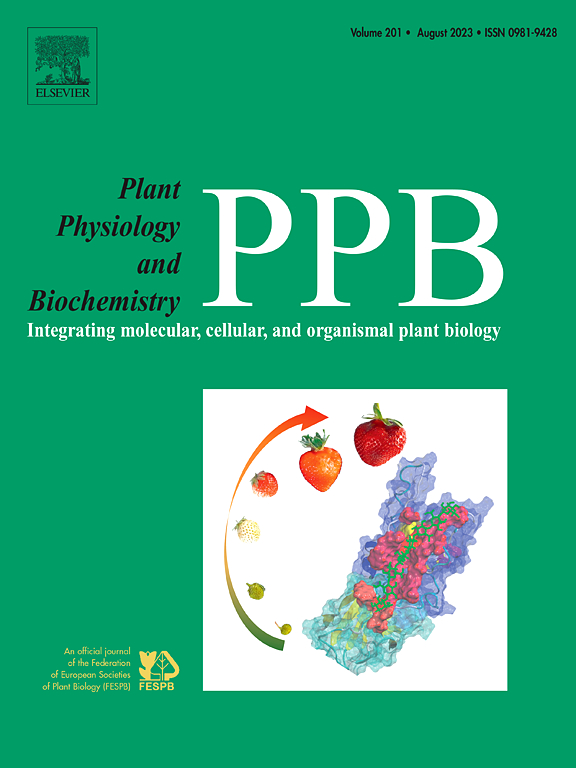Genome-wide identification of the PYL gene family and functional validation of SiPYL3 in foxtail millet (Setaria italica)
IF 5.7
2区 生物学
Q1 PLANT SCIENCES
引用次数: 0
Abstract
PYL (pyrabactin resistance-like) functions not only as a receptor but also as a crucial component in the ABA signaling pathway. Nevertheless, the functions of the SiPYL genes in foxtail millet remain largely unexplored. In this study, a comprehensive bioinformatics-based analysis of the PYL gene family in foxtail millet was conducted across the whole genome. As a result, ten SiPYL genes were identified and subsequently classified into three groups. Additionally, an in-depth investigation was carried out on the gene structure, conserved motifs, chromosomal localization, cis-acting elements, collinearity, and expression patterns of these SiPYL genes. The expression profiles of SiPYL family members under drought, salt, and ABA treatments suggested that they might adopt distinct strategies in response to adverse environmental conditions. Based on the qRT-PCR results, we found that the transcript levels of SiPYL3 were significantly upregulated under various abiotic stress conditions. Functional verification demonstrated that SiPYL3 might play a role in weakening drought resistance while positively modulating salt tolerance during the seedling stage. Furthermore, the overexpression of SiPYL3 leads to an increase in both the grain number and grain weight in rice. The outcomes of haplotype analysis indicated that SiPYL3HAP4 exhibited a higher thousand grain weight compared with other SiPYL3 haplotypes. In conclusion, our results revealed the fundamental characteristics of the SiPYL gene family and laid a solid basis for the breeding of high-yield and stress-tolerant foxtail millet varieties.
谷子PYL基因家族的全基因组鉴定及SiPYL3基因的功能验证
PYL (pyrabactin resistance-like)不仅是一种受体,而且是ABA信号通路的重要组成部分。然而,谷子SiPYL基因的功能在很大程度上仍未被探索。本研究对谷子PYL基因家族进行了全基因组的生物信息学分析。结果,鉴定出10个SiPYL基因,并将其分为3组。此外,对SiPYL基因的基因结构、保守基序、染色体定位、顺式作用元件、共线性和表达模式进行了深入的研究。SiPYL家族成员在干旱、盐和ABA处理下的表达谱表明,它们可能采取不同的策略来应对不利的环境条件。基于qRT-PCR结果,我们发现SiPYL3的转录物水平在各种非生物胁迫条件下均显著上调。功能验证表明,SiPYL3可能在苗期发挥减弱抗旱性的作用,同时正向调节耐盐性。此外,SiPYL3的过表达导致水稻粒数和粒重的增加。单倍型分析结果表明,SiPYL3HAP4比其他SiPYL3单倍型表现出更高的千粒重。研究结果揭示了SiPYL基因家族的基本特征,为选育高产耐寒谷子品种奠定了坚实的基础。
本文章由计算机程序翻译,如有差异,请以英文原文为准。
求助全文
约1分钟内获得全文
求助全文
来源期刊
CiteScore
11.10
自引率
3.10%
发文量
410
审稿时长
33 days
期刊介绍:
Plant Physiology and Biochemistry publishes original theoretical, experimental and technical contributions in the various fields of plant physiology (biochemistry, physiology, structure, genetics, plant-microbe interactions, etc.) at diverse levels of integration (molecular, subcellular, cellular, organ, whole plant, environmental). Opinions expressed in the journal are the sole responsibility of the authors and publication does not imply the editors'' agreement.
Manuscripts describing molecular-genetic and/or gene expression data that are not integrated with biochemical analysis and/or actual measurements of plant physiological processes are not suitable for PPB. Also "Omics" studies (transcriptomics, proteomics, metabolomics, etc.) reporting descriptive analysis without an element of functional validation assays, will not be considered. Similarly, applied agronomic or phytochemical studies that generate no new, fundamental insights in plant physiological and/or biochemical processes are not suitable for publication in PPB.
Plant Physiology and Biochemistry publishes several types of articles: Reviews, Papers and Short Papers. Articles for Reviews are either invited by the editor or proposed by the authors for the editor''s prior agreement. Reviews should not exceed 40 typewritten pages and Short Papers no more than approximately 8 typewritten pages. The fundamental character of Plant Physiology and Biochemistry remains that of a journal for original results.

 求助内容:
求助内容: 应助结果提醒方式:
应助结果提醒方式:


